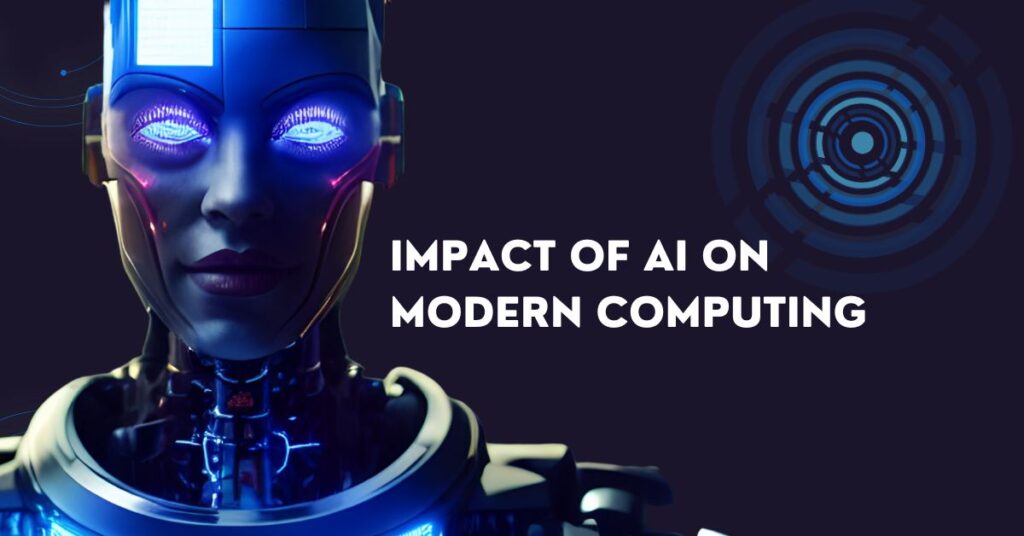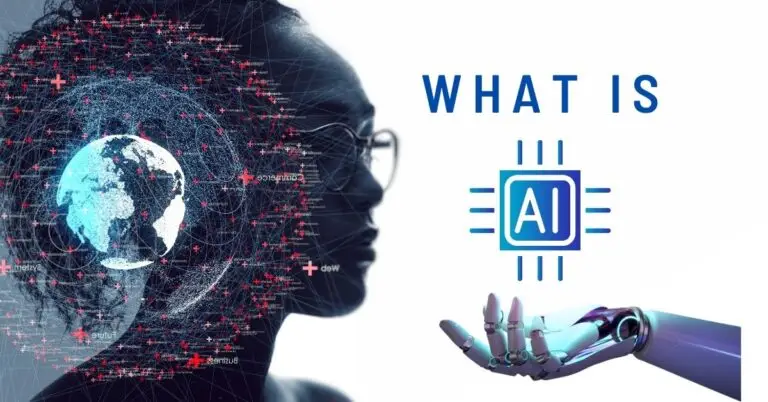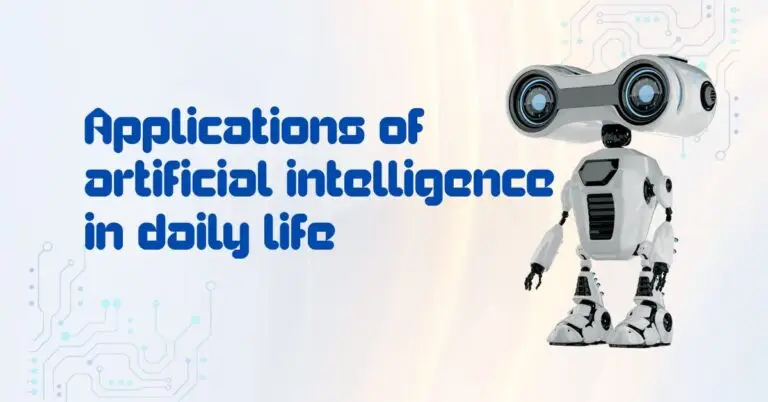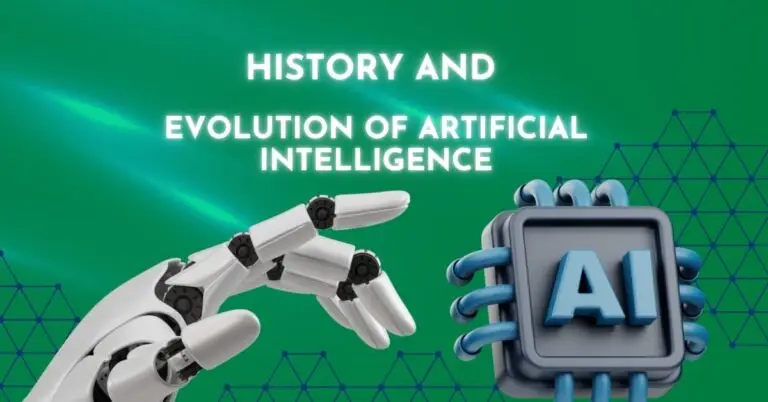Exploring artificial intelligence (AI) is truly awe-inspiring. It has changed how we use technology today. AI has moved from a dream to a key player in our tech world. It’s making our future look bright, where humans and machines work together seamlessly.
In this article, you’ll see how AI is changing computing. You’ll learn about machine learning, neural networks, and more. These technologies are making our interactions with computers better and more efficient. Get ready to see how AI is changing our world, from work to our everyday lives.
Introduction to AI’s Impact on Computing
Artificial intelligence (AI) has changed computing a lot. AI is getting better fast and is now a big part of computing’s future. It’s changing how we do things, thanks to machine learning and neural networks.
AI’s Rapid Evolution and Growing Significance
In the last ten years, AI has made huge leaps. It can now solve tough problems quickly and accurately. AI is everywhere, from helping us talk to virtual assistants to making self-driving cars work.
The Convergence of AI and Modern Computing
AI and computing working together has changed everything. New hardware like GPUs and AI chips help AI run faster. Also, more data and better ways to process it have made AI smarter. This has helped machine learning applications and neural networks learn and decide better.
| Impact of AI on Modern Computing | Key Trends |
|---|---|
| Increased Efficiency | Automated decision-making, predictive analytics, and optimization |
| Enhanced Automation | Robotic process automation, intelligent assistants, and autonomous systems |
| Improved Decision-Making | AI-driven insights, pattern recognition, and data-driven decision support |
| Personalized Experiences | Customized recommendations, user-centric interfaces, and adaptive experiences |
As AI’s role in computing grows, companies are using it to get better. They want to serve their customers better and innovate more. The mix of AI and computing is opening up new chances and challenges that we’ll look at next.
Machine Learning: The Driving Force
Machine learning has changed computing, making computers learn and decide on their own. It uses supervised and unsupervised learning algorithms. These have changed how we do tasks like recognizing images, understanding language, and predicting outcomes.
Supervised and Unsupervised Learning Algorithms
Supervised learning uses labeled data to train computers. It helps them spot patterns and make good predictions. It’s great for finding spam, catching fraud, and diagnosing diseases.
Unsupervised learning looks at data without labels. It finds hidden patterns and insights. This can lead to new discoveries.
Deep Learning and Neural Networks
Deep learning and neural networks have pushed machine learning forward. They work like the human brain, making computers understand complex data well. This has changed AI, making it better at recognizing images and understanding language.
Deep learning is key to AI’s future. It lets machines truly understand and interact with the world.
| Machine Learning Technique | Key Applications | Advantages |
|---|---|---|
| Supervised Learning | Spam detectionFraud identificationMedical diagnosis | Accurate predictionsReliable pattern recognitionStructured data processing |
| Unsupervised Learning | Accurate predictionsReliable pattern recognition structure data processing | Uncover hidden insightsDiscover new patternsExplore unstructured data |
| Deep Learning | Anomaly detectionRecommendation systems market segmentation | Image recognition natural language processingPredictive analytics |
Natural Language Processing: Bridging the Gap
Welcome to the world of natural language processing (NLP)! This technology makes it easy for humans and machines to talk to each other. It’s changing how we use computers, making them more friendly and easy to use.
NLP lets machines understand and create human language. It uses smart algorithms and learning to help chatbots and translators talk like us. This makes them very good at getting what we mean.
Voice-controlled intelligent assistants are a big deal thanks to NLP. They can listen to what you say and do things for you. They even know what you might need before you ask.
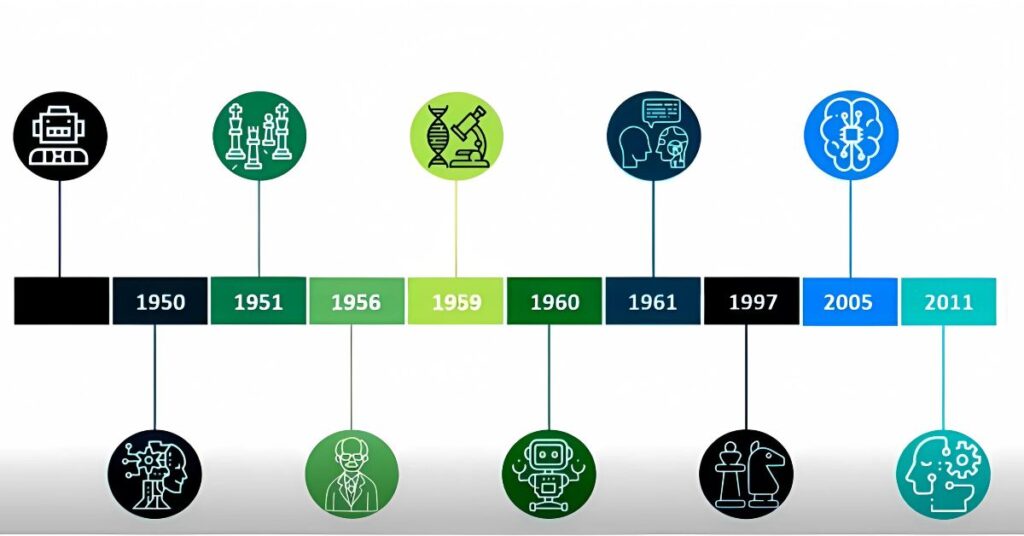
Chatbots powered by NLP have changed customer service. They work all the time and can talk to you in a way that feels personal. This means you get help whenever you need it, without waiting for a person.
Natural language processing does more than just help with assistants and customer service. It’s also key for translating languages. This lets people from different countries talk to each other easily, without language getting in the way.
The future of natural language processing looks very promising. It will make our lives easier and help us connect with others around the world. NLP is set to change how we use technology and how we talk to each other.
Computer Vision: Seeing the World through AI’s Eyes
Computer vision has changed a lot thanks to AI. AI-powered computer vision lets machines see and understand the world in new ways. It’s changing how we do things in many fields.
Object Recognition and Image Analysis
At the core of computer vision is recognizing and analyzing objects in images and videos. AI can now spot and sort many objects very well. This helps with things like self-driving cars and better security systems.
This tech is also making big changes in retail, healthcare, and manufacturing. It helps make decisions and improve how things work.
Autonomous Vehicles and Robotics
The mix of computer vision and autonomous vehicles has changed the car world. Self-driving cars use AI to see and react to their surroundings. They can spot people, cars, and lights very well.
This makes driving safer and more convenient. It also opens up new ideas in robotics. AI robots with computer vision are changing many fields. They make complex tasks easier and work better.
| Technology | Application | Key Benefits |
|---|---|---|
| Computer Vision | Autonomous Vehicles | Improved safety, convenience, and efficiency in transportation |
| Computer Vision | Robotics | Automation of complex tasks, increased productivity, and enhanced efficiency in various industries |
As computer vision gets better, we’ll see even more amazing things. It lets machines see the world in a new, smart way. This opens up endless possibilities for new ideas and progress.
Big Data Analytics and AI: A Powerful Combination
In today’s digital world, data is growing fast. This change has made businesses and organizations rethink how they make decisions. Big data analytics and AI together bring new insights and smarter decisions.
Predictive Analytics and Decision-Making
Big data analytics and AI give organizations a big boost. Predictive analytics lets them see what’s coming, spot risks, and make choices that grow their business.
By using big data analytics and AI, companies can look at lots of data. They find patterns and get insights that help them make better decisions. This helps them stay ahead in the market and give customers what they want.
| Key Benefits of Big Data Analytics and AI | Examples |
|---|---|
| Improved predictive modeling enhanced decision-making capabilitiesIncreased operational efficient personalized customer experiences | Predictive maintenance for machineryPersonalized product recommendationsFraud detection and preventionOptimized supply chain management |
As more organizations use big data analytics and AI, they find new ways to grow and stay ahead. With these tools, they can make smart choices, run their operations better, and reach new heights.
Impact of AI on Modern Computing
Artificial intelligence (AI) has changed the world of computing a lot. It makes computers work smarter and faster. This change is making computing better in many areas.
AI’s biggest change is machine learning. It can look at lots of data and find patterns. This helps in many areas like talking to computers and understanding pictures.
| AI Application | Impact on Modern Computing |
|---|---|
| Natural Language Processing (NLP) | Enables intelligent chatbots, language translation, and sentiment analysis, improving customer service and communication. |
| Computer Vision | Powers object recognition, facial identification, and autonomous systems, transforming industries like healthcare, transportation, and security. |
| Predictive Analytics | Leverages AI-driven insights to forecast trends, optimize decision-making, and drive business growth. |
AI is also making smart devices and assistants. These can talk to us and do things on their own. They make our lives easier and more fun. AI is also helping keep computers safe from bad guys.
AI is changing computing in big ways. It’s making things better and more efficient. It’s also changing how we use technology every day.
Intelligent Assistants: AI at Your Service
Modern computing has been changed by intelligent assistants powered by AI. These virtual helpers, like Alexa, Siri, and Google Assistant, offer personalized experiences. They also make our lives more efficient and convenient.
Personalized Experiences and Efficient Workflows
AI-powered intelligent assistants are designed to meet your needs and preferences. They adapt to your habits and preferences. Whether it’s setting reminders, checking the weather, or controlling smart home devices, they handle tasks easily.
Integrating intelligent assistants into our workflows boosts productivity and efficiency. They automate repetitive tasks, saving you time. This lets you focus on more important tasks. From scheduling appointments to managing to-do lists, they make your daily routines more productive and efficient.
| Feature | Benefit |
|---|---|
| Personalized Recommendations | Tailored suggestions based on your preferences and habits |
| Automated Task Management | Effortless scheduling, reminders, and task completion |
| Voice-Controlled Commands | Hands-free interaction for enhanced convenience |
| Contextual Understanding | Ability to interpret and respond to your specific needs |
The future of intelligent assistants looks bright. They will continue to improve our personalized experiences and workflows. They will remain essential tools in our modern computing world.
AI and Cybersecurity: Protecting the Digital World
The digital world is changing fast, and we need strong cybersecurity more than ever. Luckily, combining cybersecurity and artificial intelligence (AI) has led to big steps forward in fighting threats.
Threat Detection and Prevention
AI has changed how we protect our digital stuff. It uses smart algorithms to quickly scan lots of data, find patterns, and spot threats. AI helps catch malware and watch for unusual network activity, always staying ahead of hackers.
AI also helps with intrusion prevention systems that act fast to stop security problems. These systems can find and fix threats on their own, saving us time and effort.
Ethical Considerations and Responsible AI
As AI gets more used in cybersecurity, we must think about its ethical considerations. It’s important to use ethical AI wisely, making sure it’s fair, open, and doesn’t discriminate.
- Strict data privacy and security measures to protect sensitive information
- Transparency in the decision-making processes of AI-powered systems
- Regular audits and testing to identify and mitigate potential biases
- Ongoing collaboration between cybersecurity experts and ethicists
By using AI wisely and following ethical AI rules, we can keep the digital world safer than ever.
The Future of AI and Computing
Artificial intelligence (AI) is growing fast, bringing big changes to computing. New trends and innovations are making AI better. This will change how we use technology and solve big problems.
Quantum Computing: The Next Frontier
Quantum computing is a big deal. It uses quantum mechanics to do calculations way faster than old computers. This tech will make AI much stronger, helping in drug discovery and more.
Neuromorphic Chips: Emulating the Brain
Neuromorphic chips are like the brain. They’re made to work like our brains, using less energy. This makes them great for AI, leading to smarter AI systems.
Edge Computing: Bringing AI to the Edge
IoT devices need fast data processing. Edge computing does this by processing data near the source. It cuts down on delays and keeps data safe, making AI better for cars and cities.
These trends and innovations will keep changing computing. They offer new chances for growth and solving big problems.
Challenges and Limitations of AI in Computing
AI is changing how we compute, but it faces many challenges and limits. From technical problems to ethical worries, we must think deeply about AI’s role in computing. We need to keep working to solve these big issues.
One big problem is data bias. AI’s quality depends on the data it learns from. If this data has biases, AI’s actions can spread and grow these biases. This can make AI unfair and discriminatory, which goes against fairness and equality.
Privacy and security are also big worries with AI. AI deals with lots of data, which raises the risk of data leaks and unauthorized access. It’s vital to use AI responsibly and ethically to keep people’s trust.
| Challenges of AI | Limitations of AI |
|---|---|
| Data Bias | Lack of Contextual Understanding |
| Privacy and Security | Dependence on Vast Data Sets |
| Transparency and Accountability | Inability to Fully Replicate Human Intelligence |
We also need transparency and accountability in AI. As AI gets smarter and more powerful, it’s key to make sure it’s not a mystery. We need to understand how AI works to build trust and use it wisely.
The limits of AI include not fully getting human context, needing lots of data, and not being as smart as humans. But, researchers and developers are working hard to fix these problems. By tackling AI’s challenges and limits, we can make sure AI is used for good in computing.
Conclusion
The impact of AI on modern computing is huge. It brings us powerful tools like machine learning, natural language processing, and computer vision. These technologies are changing how we use and interact with computers.
AI and computing together have opened up new areas like data analytics, cybersecurity, and personalized experiences. You’ve seen how AI can handle big data, find threats, and offer solutions that fit your needs.
The future of AI and computing looks bright. Trends like edge computing, quantum AI, and ethical AI are on the horizon. These will take computing to new heights. Even with challenges, AI is set to make computing even better.
FAQ
What is the impact of AI on modern computing?
Artificial Intelligence (AI) is changing how we use computers. It’s making data processing, analysis, and interaction better. AI is using machine learning, neural networks, and more to improve computing and solve problems.
How are machine learning and deep learning algorithms driving the advancement of AI?
Machine learning lets computers learn and decide on their own. Deep learning and neural networks have made AI more accurate. This helps in image recognition, language processing, and predicting future events.
What is the role of natural language processing (NLP) in bridging the gap between humans and machines?
NLP lets computers understand and create human language. This makes interactions with computers more natural. It’s improving how we talk to and use computers.
How is computer vision transforming industries and paving the way for new innovations?
Computer vision lets machines see and understand the world. It’s changing industries like cars, robots, and security. Machines can now interpret the physical world better.
How are big data analytics and AI working together to drive better decision-making?
Big data and AI together provide better insights and decisions. They’re helping industries make smarter choices. This is leading to better operations and customer experiences.
What is the role of intelligent assistants in modern computing?
Intelligent assistants, like Alexa and Siri, are making life easier. They offer personalized help and automate tasks. This boosts productivity and convenience.
How is AI being applied in cybersecurity to protect the digital world?
AI is helping in cybersecurity by detecting threats. But, there are ethical issues to consider. It’s important to use AI responsibly and securely.
What are the emerging trends and innovations in the future of AI and computing?
The future of AI and computing is exciting. Quantum computing, neuromorphic chips, and edge computing are leading the way. These advancements will enhance AI’s capabilities and impact.
What are the challenges and limitations of AI in computing?
AI has made a big impact, but there are still challenges. Issues like data bias, privacy, and accountability need to be addressed. Efforts are underway to ensure AI is used responsibly and for the greater good.

